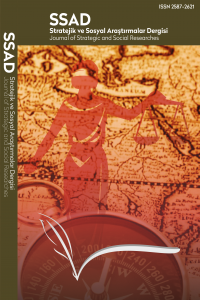Çin’in Yumuşak Güç Araçlarının İncelenmesi
Yumuşak Güç, Çin, Kültür, Dış Politika, Siyasi Değerler
AN EXAMINATION OF CHINA’S SOFT POWER INSTRUMENTS
Soft Power, China, Culture, Foreign Policy, Political Values.,
___
- ARIBOĞĞAN, ÜÜ. (2001). ÇÇin’in Göölgesinde Uzakdoğğu Asya. İİstanbul: Bağğlam Yayınları.
- CARR, E. H. (1962). The Twenty Years’ Crisis 1919-1939 (1939). An Introduction to the Study of International Relations. London: Macmillan.
- CHÉN, Y. (2007). Shì Lùn Quánqiú Huà Bèijǐng Xià Zhōngguó Ruǎn Shílì de Gòujiàn. Guójì Guānchá, (2), 8.
- CHÉN, Z. (2008). Zēngqiáng Zhōngguó Wénhuà Ruǎn Shílì Lùn Yào. Zhèjiāng Shèhuì Kēxué, (2), 87-92.
- CHÉN, Z. XUĒ, X. and HÉ, X. (2009). Xī Hǎiwài Huáqiáo Huárén Zài Tuīdòng Zhōngguó Ruǎn Shílì Xíngchéng hé Fāzhǎn Guòchéng Zhōng de Zuòyòng. Zhèjiāng Xué Kān, 6 (127), 14.
- China Cultural Industry Association, (2022, 06 December). http://www.chncia.org/en/about.php?mid=7#:~:text=replica%20watches%20uk%20China%20Cultural,in%20Ministry%20of%20Civil%20Affairs
- China Public Diplomacy Association. (2022, 01 December). http://www.chinapda.org.cn/eng/xhgk/xhjj/
- D’Hooghe. (2015). China’s Public Diplomacy. Netherlands: Koninklijke Brill.
- DOWDING, K. (2012). Why Should We Care About the Definition of Power?. Journal of Political Power, 5 (1), 119-135.
- FARAH, D. and MOSHER, A. (2010). Winds From the East. Washington, DC: Center for International Media Assistance.
- FOOT, R. (2014). ‘Doing Some Things’ in the Xi Jinping Era: The United Nations as China's Venue of Choice. International Affairs, 90 (5), 1085-1100.
- GIL, J. (2008). The Promotion of Chinese Language Learning and China‟s Soft Power. Asian Social Science. 4 (10), 116-122.
- GLASER, B. S. and MURPHY, M. E. (2009). Soft Power With Chinese Characteristics. Chinese Soft Power and its Implications for the United States, 10-26. GUO, S. (2007). Xīn guójì zhǔyì yǔ Zhōngguó ruǎn shílì wàijiāo. Guójì guānchá, (2), 43-52.
- HE, K. and FENG, H. (2014). China’s Bargaining Strategies for a Peaceful Rise: Successes and Challenges. Asian Security, 10 (2), 168-187.
- HONGHUA, M. (2007). An Evaluation of China’s Soft Power and Promotion Strategy. China’s Soft Power Strategy. https://chinacopyrightandmedia.wordpress.com/2006/09/13/outline-of-the-national-11th-five-year-plan-period-cultural-development-plan/
- Hu Jintao. (2006). Speech on the Eighth National Congress of the China Federation of Literary and Art Circles, on November 10, 2006. (2022, 05 December). http://culture.people.com.cn/GB/22219/5026372.html
- HU, S. (1997). Confucianism and Western Democracy. Journal of Contemporary China, 6 (15), 347-363.
- HUANG, Y. and DING, S. (2006). Dragon’s Underbelly: An Analysis of China’s Soft Power. East Asia, 23 (4), 22-44.
- KALATHIL, S. (2011). China’s Soft Power in the Information Age: Think Again. Institute For the Study of Diplomacy, ISD Working Papers in New Diplomacy.
- KEOHANE, R. O. and NYE, J. S. (1987). Power and Interdependence Revisited. International Organization, 41 (4), 725-753.
- KURLANTZICK, J. (2007). Charm Offensive: How China's Soft Power is Transforming the World. New York: Yale University Press.
- LI, X. and WORM, V. (2011). Building China’s Soft Power for a Peaceful Rise. Journal of Chinese Political Science, 16 (1), 69-89.
- MÉN, H. (2012). Zhōngguó Ruǎn Shílì Pínggū Bàogào. Guóqíng Bàogào (dì shí juǎn 2007 nián (shàng)), 15-26.
- NYE Jr, J. S. (1990). Bound to Lead: The Changing Nature of American Power. New York: Basic Books.
- NYE Jr, J. S. (2004). Soft Power: The Means to Success in World Politics. New York: Public Affairs. Outline of the National “11th Five Year Plan” Period Cultural Development Plan. (2006). (2022, 01 December).
- PEKCAN, C. (2016). Çin’in Kültürel Diplomasisinin ‘Çin Tehdidi’ Algısının Kırılmasındaki Önemi. In International Conference on Eurasian Economies, 212-219.
- PLA Development Dteady and Peaceful, 2022. (2022, 01 December). http://eng.chinamil.com.cn/2022special/2022-08/01/content_10175182.html
- PREUSS, H. (2007). Signaling Growth: China’s Major Benefit From Staging the Olympics in Beijing 2008. Harvard Asia Pacific Review, 9 (1), 45-49.
- REESE, L. (2000). (2022, 01 December). Women as Cultural Emissaries: Consider Women as “Diplomat Brides”. Women in World History Curriculum: http://www.womeninworldhistory.com/essay-10-11.html
- SHAMBAUGH, D. (2015). China's Soft-Power Push: The Search for Respect. Foreign Affairs, 94 (4), 99-107.
- Shanghai Bureau of World Expo Coordination Executive 2010. (2022, 01 December). Expo announcement. Retrieved from http://www.Expo2010.cn/gfzygg/more.htm
- SNOW, E. (1968). Red Star Over China. 1938 (Rev. and enl. Ed). New York: Grove.
- TZU, S. (2008). The Art of War. In Strategic Studies (pp. 63-91). Routledge.
- WANG, Y. (1999). Zhongguo Dalu Guoji Zhengzhi Lilun Yanjiu de Ruogan Wenti (Reflections on the Studies of International Political Theory in Mainland China). East Asian Journal, 30 (3):71-90.
- WANG, Y. (2008). Public Diplomacy and the Rise of Chinese Soft Power. The Annals of the American Academy of Political and Social Science, 616 (1), 257-273.
- XI, J.P. (2014). Elevate Soft Power, Realize the Chinese Dream. People’s Daily.
- XİÀO, Y. and ZHĀNG, T. (2010). Zhōngguó Wénhuà Ruǎn Shílì Yánjiū De Huígù Yǔ Qiánzhān. Húnán Dàxué Xuébào (shèhuì kēxué bǎn), (1), 12-17.
- ZHANG, J. (2015). China's New Foreign Policy Under Xi Jinping: Towards ‘Peaceful Rise 2.0’?. Global Change, Peace & Security, 27 (1), 5-19.
- ZHĀNG, X. and LUŌ J. (2008). Zhōngguó Ruǎn Shílì de Pínggū Yǔ Fāzhǎn Lùjìng. Guójì lùntán, (5), 24-29.
- ZHANG, Y. (2000). The 'English School in China: a Story of How Ideas Travel and are Transplanted.
- ZHÀO, L. (2007). Lǐjiě Zhōngguó Ruǎn Shílì de Sān Gè Wéidù: Wénhuà Wàijiāo, Duōbiān Wàijiāo, Duìwài Yuánzhù Zhèngcè. Shèhuì Kēxué Lùntán, (5), 150-157.
- ZHAO, S. (2012). China's Foreign Policy as a Rising Power in the Early Twenty-First Century. China's Soft Power and International Relations, 195-197.
- ZHU, M. (2002). The Role of Soft Power in International Relations. Cultural Impact on International Relations. Washington, DC: The Council for Research in Values and Philosophy.
- ISSN: 2587-2621
- Yayın Aralığı: Yılda 3 Sayı
- Başlangıç: 2017
- Yayıncı: Mehmet Ali KARAMAN
NEFRET SÖYLEMİ VE İSLAMOFOBİ: FRANSA BASINI ÖRNEĞİ
GELENEKSEL ANTEP İŞİ NAKIŞLARDA TOPLUMSAL BELLEĞİN İZLERİ: BEBEKLİ MOTİF
Süreyya EROĞLU BİLGİN, Evren YILMAZ
ENVER PAŞA’NIN TABUR MEKTEPLERİ DENEMESİ
SİLİFKE KALESİ HİSARPEÇE BÖLÜMÜ KAZILARI
EĞİTİMDE YENİLİKÇİ TEKNOLOJİLERİN KULLANIMI VE ÇAĞDAŞ İÇERİK TASARLAMA
YAPAY ZEKÂ İLETİŞİMİNDE CHATGPT: İNSANLAŞAN DİJİTALLEŞMENİN GELECEĞİ
Ahmet KOÇYİĞİT, Abdülhakim Bahadır DARI
“MEMLÛK” SÖZCÜGÜ: BASİT ANLAMINDAN ASKERİ VE SİYASİ TERİM ANLAMINA
